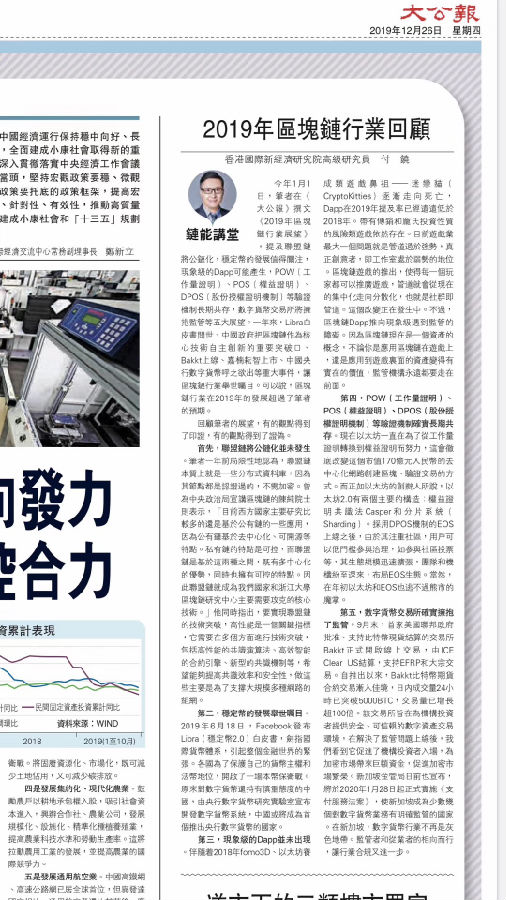———— Release time:2020-02-12 Edit:HKINERI Tony Fu Read:28 ————
On 1 January 2019, the author wrote the "Blockchain Industry Outlook 2019" in Ta Kung Pao, mentioning that the alliance chain will be publicly chained, and the development of stable coins is worthy of attention. Phenomenal Dapps may be generated. ), POW (Proof of Work)、POS (Proof of Equity)、DPOS (Share Authorization Proof Mechanism) and other verification mechanisms co-exist for a long time. Digital currency exchanges will embrace five major prospects such as supervision. In the past year, the Libra White Paper came out, the Chinese government took blockchain as an important breakthrough in independent innovation of core technologies, the launch of Bakkt, the listing of Canaan and the emergence of digital currency by the people’s bank of China attracted worldwide attention. It can be said that the development of the blockchain industry in 2019 exceeded my expectations.
Looking back at the author's outlook, some views have been confirmed, and some views have been falsified.
First, the communization of alliance chain did not happen. The author limitedly believed a year ago that the alliance chain is essentially some distributed database, because its nodes are all authenticated and do not need encryption. Academician Chen Chun, who once preached the Blockchain for the Political Bureau of the Central Committee, said, "At present, most of the research in Western countries is still based on some applications of public chains, because public chains are based on decentralization, open source and other characteristics. Features of private chains is controllable, and the alliance chain is based on these two types. It has both the advantages of multi-centralization and controllable characteristics. Therefore, the alliance chain has become the core technology that our country and the Blockchain Research Center of Zhejiang University need to overcome." He also pointed out that in order to achieve the technological breakthrough of the alliance chain, high performance is a key indicator. It requires technological breakthroughs in multiple aspects, including high-performance consensus algorithms, efficient and intelligent contract engines, and new types of consensus. Mechanism, etc., hope to improve the efficiency and security of consensus. The main purpose of this is to support large-scale multi-network networking.
Second, the development of stable currency attracted worldwide attention. On 18 June 2019, Facebook released the Libra (Stable Coin 2.0) white paper, which refers to the international monetary system, causing tension in the entire financial world. In order to protect their currency sovereignty and fiat currency status, countries have launched a domestic currency defense war. China, which originally had a cautious attitude towards digital currencies, is developing a digital currency system announced by the Digital Currency Research Lab of the Central Bank to. China may become the first country to launch a digital currency of the Central Bank.
Third, phenomenal Dapps have not appeared. With the gradual death of CryptoKitties, the originator of fomo3D and the Ethereum-developed games in 2018, the mention rate of Dapp in 2019 is far lower than in 2018. Risky games with the nature of MLM and Ponzi investment still exist. At present, the biggest problem of the game industry is that the pipeline is too strong, and the real creative person, that is, the studio is in a weak position. With the launch of blockchain games, every player can promote the game, and the pipeline will change from the current centralized to decentralized, that is, the community is the pipeline. This change is happening. However, the blockchain Dapp encountered regulatory obstacles to the phenomenon level. Because blockchain is now a concept of assets, whether you apply blockchain to games or games assets which become real value, regulators should always be ahead.
Fourth, verification mechanisms such as POW (Proof of Work), POS (Proof of Equity), and DPOS (Share Authorization Proof Mechanism) do coexist for a long time. Now Ethereum has been working hard to convert from proof of work to proof of equity, which will completely change the way this 17 billion yuan market capitalization decentralized network creates blocks and verifies transactions. And as the founder of Ethereum said, Ethereum 2.0 has two main structures: the proof-of-stake consensus method Casper and the sharding system. After the EOS adopting the DPOS mechanism was launched, due to its focus on the community, users can participate in governance with a low threshold, such as participating in community voting. Its ecological scale has expanded rapidly, and teams and institutions have come in, laying out the EOS ecosystem. Of course, at the beginning of the year, Ethereum and EOS could not escape the clutches of the bear market.
Fifth, digital currency exchanges have indeed embraced regulation. At the end of September, Bakkt, the first exchange approved by the US federal government and support for Bitcoin spot settlement, officially opened online trading. It is settled by ICE Clear US, and support EFRP and bulk transactions. Since its launch, Bakkt bitcoin futures contract transactions have gradually entered a favorable situation. The daily trading volume has exceeded 5000 BTC in 24 hours, and the trading volume has increased by more than 100 times. The exchange aims to provide institutional investors with a secure and reliable digital asset trading environment. After solving the regulatory issue online, we see that it has promoted institutional investors' entry, brought huge funds to the crypto market, and promoted crypto the market is booming. The Monetary Authority of Singapore also announced that it will officially implement “Payment Services Act” from 28 January 2020, making Singapore one of the few countries with clear regulation of digital currency business. In Singapore, the digital currency industry is no longer a grey area. Regulators and practitioners work together to make compliance Industry closer.
